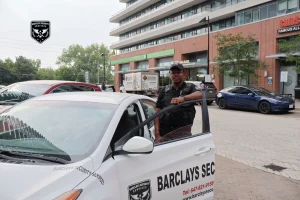Summary
Mobile patrol security helps Canadian organizations lower insurance premiums by cutting both the number and the size of incidents and by producing GPS-verified, evidence-rich reports underwriters trust. Randomized, risk-weighted routes, verified alarm response, and time-stamped photos or body-cam clips reduce false dispatches, compress response times, and push incident trends down. Barclays Security Services wraps it all in monthly Underwriter Packs and quarterly risk reviews, so your broker can pursue mid-term credits or sharpen terms at renewal with confidence.
Introduction
Canadian underwriters don’t price on promises-they price on expected loss and confidence in your controls. Mobile patrol security lowers both loss frequency and severity while producing audit-ready documentation that loss-control teams actually trust. When patrol vehicles run randomized, risk-weighted routes across your properties, visible presence deters opportunistic crime and structured checks catch small hazards-an unlatched gate, a leaking pipe, a loiterer-before they escalate into claim-worthy events. Tie those patrols to GPS proof of presence, verified alarm response, body-worn video, and incident reporting, and you’ve translated day-to-day security work into underwriting evidence. That’s how Canadian firms convert security spend into premium credits and better terms.
Why Canadian Insurers Care: The Underwriting Reality
Premiums in Canada reflect your exposures, controls, past losses, and the carrier’s confidence in your documentation. Show a loss-control inspector unlocked doors, dark lots, and “trust us” claims-you get loaded. Show documented patrols, geofenced checkpoints, response times, incident trendlines, and policy compliance-you’re positioned for credits. In provinces with strict false-alarm bylaws, verified response from mobile patrols is especially valuable; it curbs fines and improves your profile with both municipalities and carriers.
How Mobile Patrols Reduce Premiums (Explained, Not Bullet-Pointed)
Mobile patrols cut risk in two ways. First, presence is deterrence. Randomized passes and marked vehicles suppress opportunistic theft and vandalism across retail lots, construction sites, warehouses, campuses, and HOAs/strata communities. Second, early detection limits severity. A patrol that finds a door ajar, catches trespassers before damage occurs, or spots a minor water leak in a mechanical room prevents escalations that normally drive claim costs. Because each patrol is GPS-verified and evidence-rich, your expected loss-the core of premium pricing-moves down. Canadian carriers also value verified alarm response: patrols physically check zones after alarms trigger, filtering false dispatches and building credibility with local police services.
Make It Insurer-Ready: The Data Package That Moves Pricing
You need receipts, not rhetoric. Package an executive summary that shows a 6-12-month improvement: incident rate per 1,000 patrols trending down, median and P90 response times compressing, false alarm dispatches decreasing due to on-scene verification, and remediation SLAs being met. Attach representative, time-stamped reports with photos or short clips (body-cam where appropriate) and a simple change log of route or SOP improvements after each quarterly review. When your broker can hand a Canadian underwriter that type of evidence, you stop arguing opinions and start presenting actuarial-grade signals.
Implementation Blueprint for Canadian Properties (30-60 Days)
Begin by mapping two or three years of loss runs to hotspots by hour and asset type. Design risk-weighted routes that focus on where claims originate rather than spreading coverage evenly for optics. Randomize patrol windows to prevent pattern gaming. Integrate alarms and CCTV so alerts land in the patrol app with timers and escalation paths. Standardize reporting with photo/video on every material incident and clear privacy signage. Over the first 60 days, iterate routes using incident heatmaps, trim dead-time loops, and tighten evidence handling. The outcome: fewer claims, smaller severities, and stronger claims defensibility-exactly the triad your broker needs to seek mid-term credits or sharpen terms at renewal.
Where It Pays Off Fast Across Canada
Construction sites see less copper/tool theft and fewer perimeter breaches; multifamily/condo communities report calmer nights and reduced parking/amenity issues; logistics yards keep trailer seals intact and catch dock-door activity early; retail centres dampen ORC spillover in parking lots without killing the customer experience; office parks avoid weekend HVAC and water-damage surprises because someone actually checked mechanical rooms after hours. The pattern is consistent coast-to-coast: smarter patrol frequency, verified alarm response, and defensible documentation.
Canadian Compliance & Best-Practice Notes (Practical, Not Legal Advice)
Operate to Canadian norms and you’ll earn trust with loss-control teams. Align fire-watch procedures with the National Fire Code of Canada and your local AHJ. Use privacy signage and access controls consistent with PIPEDA (and any applicable provincial privacy acts). Ensure licensing compliance under your province’s security legislation (e.g., PSISA in Ontario, Security Services Act in B.C., Security Services and Investigators Act in Alberta). Where relevant, lean on ULC-recognized practices for alarm handling and monitoring. You’re signalling professionalism-and underwriters notice.
What to Track and Show (So Your Broker Can Win the Argument)
Treat your patrol platform like a telemetry engine. Track patrol completion percentage by zone and shift (with GPS breadcrumbs), incident rate per 1,000 patrols, median and P90 response times, photo/video attachment rates, time-to-remediate, and false alarm rate. Present those as clean charts with a short narrative on what you changed and why. That’s the underwriting language Canadian carriers respect.
Barclays Security Services (Canada): Mobile Patrols Built for Underwriters
Barclays Security Services is designed for property managers, developers, HOAs/condos, logistics operators, retail REITs, and campuses that need security outcomes and insurer-friendly documentation. Their mobile patrol programme uses geofencing for auditable proof of presence, randomized but risk-weighted routing that aligns patrol frequency with exposure, and real-time incident reporting that includes time-stamped photos or body-cam clips, remediation notes, and optional chain-of-custody. The verified alarm response workflow reduces false dispatches and municipal fines while boosting credibility with law enforcement. What clients value most is the documentation cadence: a monthly Underwriter Pack with KPIs and trendlines and a quarterly risk review that records route adjustments, seasonal risk shifts, and reductions in incident densities. Hand that to your broker, and you’re not pitching-you’re proving.
Frequently Asked Questions
1) Will mobile patrols guarantee lower premiums in Canada?
No one can guarantee a premium cut. What patrols do-reliably-is reduce claim frequency and severity and improve documentation. When those trends hold for six to twelve months, brokers have leverage to request credits or better terms at renewal.
2) How fast might I see pricing movement-mid-term or only at renewal?
Most carriers prefer renewal-cycle decisions once a stable trend is visible. That said, a strong 60-90-day pilot with clear improvements can justify mid-term consideration; your broker will advise based on market appetite.
3) What’s the right patrol frequency for my sites?
Risk-weighted. High-loss zones get more randomized passes; low-risk zones get fewer. The goal is maximum risk reduction per dollar, not equal coverage for optics.
4) Do underwriters really value GPS “proof of presence”?
Yes. GPS breadcrumbs and geofenced checkpoints validate that patrols occurred as scheduled. Confidence in controls is a core pricing input.
5) Why is verified alarm response such a big deal in Canadian cities?
Because many municipalities penalize chronic false alarms. Physical verification by patrols reduces false dispatches, cuts fees, and improves your standing with both police services and insurers.
6) How do patrols reduce loss severity, not just frequency?
Early detection wins. Finding a minor water leak at midnight prevents a Monday-morning flood claim. Removing trespassers quickly prevents theft, damage, and liability escalations.
7) What evidence best supports claims defensibility?
Time-stamped photos, short video or body-cam clips, and clear chain-of-custody notes. These reduce dispute cycles and fraud exposure.
8) Are body-worn cameras necessary in Canada?
Not mandatory, but they materially strengthen evidence and accountability. Use clear policies, privacy signage, and reasonable retention schedules aligned with Canadian privacy law.
9) How should patrol operations align with my insurance program?
Start with your loss runs and any carrier recommendations. Build routes to target the actual drivers of loss, then present before/after trendlines and what you changed to address them.
10) Can mobile patrols replace static guards?
Sometimes. For large, low-to-moderate-risk footprints, mobile patrols cover more terrain efficiently. High-risk entry points often warrant a hybrid of static and mobile.
11) Which KPIs matter most to Canadian underwriters?
Patrol completion %, incident rate per 1,000 patrols, median/P90 response times, false alarm rate, photo/video evidence rate, and time-to-remediate. Present them consistently.
12) How do seasons affect patrol design across Canada?
Holiday peaks, long winter nights, storm seasons, and construction cycles change risk. Rebalance routes quarterly and document the rationale.
13) Will patrols improve tenant or resident sentiment?
Yes. Visible presence and faster issue resolution reduce complaints and churn-indirectly improving your risk environment.
14) How do mobile patrols help construction projects?
They deter copper and tool theft, protect generators and fuel, verify fence integrity, and provide after-hours checks that align with insurer expectations for high-theft phases.
15) How do I randomize routes without losing coverage?
Use time windows rather than fixed timestamps and rotate sequence orders while preserving total pass counts per zone. You defeat pattern-watchers while protecting SLAs.
16) Will premiums move before deductibles?
Typically, yes. Deductible adjustments may come after your overall risk posture and loss experience improve. Your broker will navigate options.
17) What format should I send to Canadian underwriters?
One concise dashboard page with trend charts, then an appendix of representative incident reports. Clarity beats a data dump.
18) Can patrols support cyber-physical security?
Absolutely. Patrols enforce physical access, protect IDFs and generators, and validate IoT/alarm events on-site, separating sensor noise from real risk.
19) How do false alarms impact my insurance?
Chronic false dispatches hint at weak controls and can trigger municipal penalties. Verified response cuts that noise and helps your reputation with both police and carriers.
20) Do I need new VMS or access control to start?
No. Start with patrols and strong reporting. Integrations amplify value and can be phased in.
21) How should we handle privacy and PII in reports and video?
Use signage, role-based access, redaction workflows for video, and sensible retention schedules aligned with PIPEDA and any provincial privacy acts.
22) What if my carrier’s loss-control letter conflicts with my patrol plan?
Align it. Treat the letter like a roadmap, adjust routes, and document changes. Showing responsiveness builds trust.
23) Which industries in Canada see the fastest ROI?
Construction, logistics/warehousing, retail centres, office campuses, and multifamily/condo communities typically see rapid gains from reduced theft, faster response, and better documentation.
24) Why choose Barclays Security Services over a generic vendor?
Because Barclays packages operations the way underwriters think: GPS-verified presence, verified alarms, evidence-rich reporting, and monthly Underwriter Packs that make credit decisions easier.





